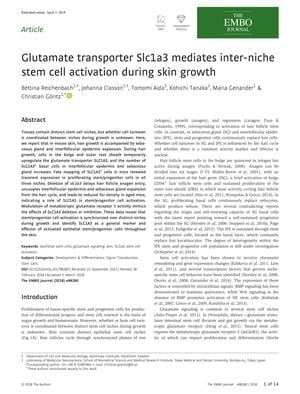Glutamate Transporter SLC1A3 Mediates Inter-Niche Stem Cell Activation During Skin Growth
April 2018
in “
EMBO journal
”

TLDR The protein SLC1A3 is important for activating skin stem cells and is necessary for normal hair and skin growth in mice.
The study found that during mouse skin growth, hair growth is synchronized with the expansion of the sebaceous gland and interfollicular epidermis. This process involves the temporary upregulation of the glutamate transporter SLC1A3 in stem/progenitor cells within the skin's distinct stem cell niches. Fate mapping in mice showed that SLC1A3+ cells are transiently expressed in proliferating cells across all three niches. Deleting the slc1a3 gene delayed the entry of hair follicles into the growth phase (anagen), disrupted the coupling of sebaceous gland and interfollicular epidermis expansion with the hair cycle, and resulted in lower fur density in older mice. This suggests that SLC1A3 plays a crucial role in the activation of stem/progenitor cells. Additionally, altering the activity of metabotropic glutamate receptor 5 had similar effects to deleting or inhibiting SLC1A3, indicating its involvement in stem/progenitor cell activation across different skin niches.








